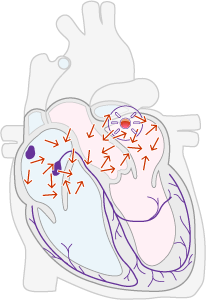Cardiology Teaching Package
A Beginners Guide to Normal Heart Function, Sinus Rhythm & Common Cardiac Arrhythmias
How Atrial Fibrillation Begins
The fibrillation, or quivering, that takes place is due to individual muscle fibres contracting independently due to the chaotic conduction within the atria. (see below)
Image: Disorganised electrical activity within the Atria

Note ectopic focus top right corner of atria.
Chaotic conduction within the atria.
The atria can respond in an organised fashion to as many as 400 stimuli per minute however, in AF, the rate of stimulation is around 600 stimuli/min. At this rate the atrial muscle cells cannot repolarise in time for the next stimulus and chaos ensues.
In sinus rhythm, the AV node is depolarised regularly by an impulse from the SA node.(60-100 stimuli/min.)
In AF there are as many as 600 stimuli/min bombarding the AV node. Many of these stimuli are weak and are therefore not conducted into the ventricles, although they can partially depolarise the AV junction. This is enough to cause a refractory period in which the AV node is unable to conduct other impulses.
A refractory period is the short period after the AV node receives a stimulus when it is unable to conduct another stimulus.
